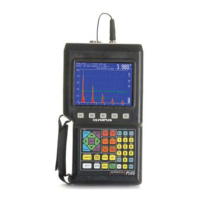Using Software Options
Part # 910-250C
87
9.2.4 Setting Alarms in DAC Mode
You can use the gates to set alarms while DAC is active. When using the ASME or ASME-
3 DAC modes, all alarms are referenced to the primary curve. When using the JIS DAC
mode, alarms are referenced to the highlighted alarm curve. For example, any DAC alarm
can be set by using the positive threshold alarm on either Gate 1 or Gate 2. Any echo that
falls within the gate and exceeds the DAC level triggers the alarm. The alarm is triggered
only if an echo exceeds the portion of the DAC curve immediately above the gate. This
same rule applies to the use of the minimum depth and negative threshold alarms while in
DAC.
Note: Alarms do not function in the area outside of the DAC curve.
9.2.5 Exiting DAC Mode
To clear the DAC curve and return to the normal operation, follow these steps:
1. Press [OPTION].
2. Use the slewing keys to highlight the DAC selection and press [ENTER] to go into
the DAC setup.
3. Use the slewing keys to highlight Off and press [ENTER].
4. Press [OPTION] to return to the A-Scan display.
9.3 Time Varied Gain (TVG)
The Time Varied Gain (TVG) option compensates or corrects for the changes in echo
amplitude from equal sized reflectors at different distances due to material attenuation and
beam spreading. When TVG is properly set up, equal sized reflectors produce indications
of equal screen height regardless of their distance. TVG has a dynamic range of 40 dB with
a minimum echo height of approximately 5%.
Note the following items when using the TVG option:
• In version 1.04 and higher of the operating software, TVG is active in all display
modes (RF, Full Wave, Half Wave +, and Half Wave -).
• In version 1.04 and higher, the zoom function is active with TVG.
• TVG and DAC may not be activated simultaneously.
• Up to 20 TVG calibration points may be programmed, separated by a minimum of
0.52 microseconds (approximately 0.06" or 1.5 mm at longitudinal velocity in steel).
• The minimum full screen range must be set greater than approximately 1" (25 mm) at
longitudinal velocity of steel to activate TVG. After a TVG curve is set up, it is
possible to zoom in to smaller range ranges than 1.000 inches.
• The maximum full screen range must be set less than approximately 120" (3050 mm)
at longitudinal velocity of steel to activate TVG.

